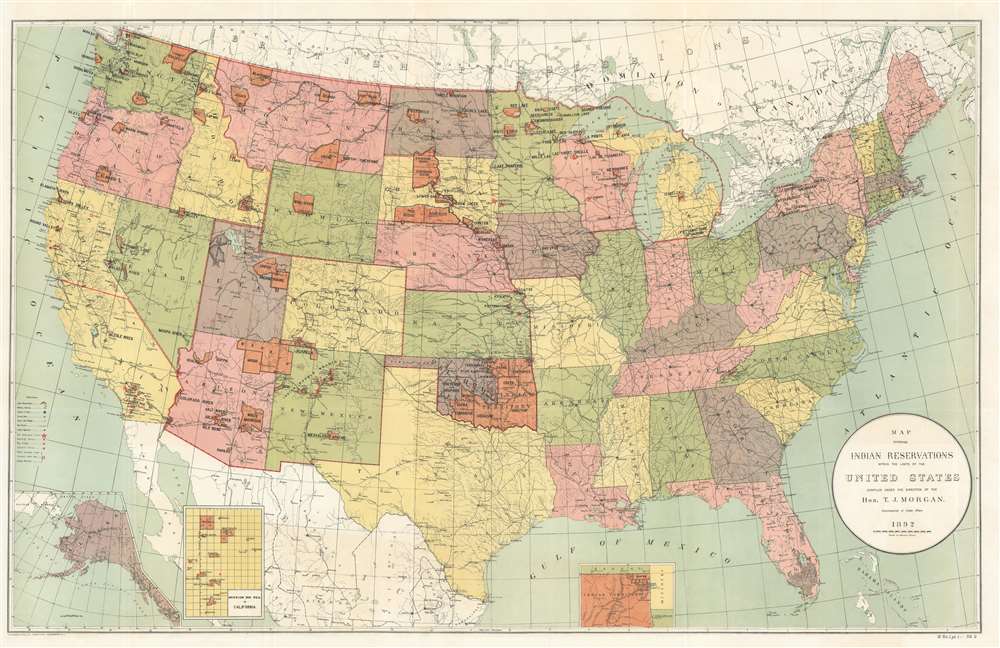This item has been sold, but you can get on the Waitlist to be notified if another example becomes available, or purchase a digital scan.
1892 Morgan Map of the United States Indian Reservations
IndianReservations-morgan-1892
Title
1892 (dated) 22 x 34 in (55.88 x 86.36 cm) 1 : 5702400
Description
Oklahoma Territory and Indian Territory
Perhaps the most intriguing part of this map is what is going on in the modern-day state of Oklahoma. Here, Oklahoma is split into two territories, the Oklahoma Territory and Indian Territory. The concept of an Indian Territory was the successor to the British Indian Reserve, which was. Established by the Royal Proclamation of 1763. After the Louisiana Purchase, President Jefferson and his successors viewed land west of the Mississippi River as available for the resettlement of Native Americans, which became official policy after the 1830 Indian Removal Act was signed by President Andrew Jackson. The Indian Territory was slowly whittled down as Americans moved west and more and more territories were formed. Wisconsin, Iowa, and the Dakotas all chipped away at land that had once belonged to Native Americans. The borders of modern-day Oklahoma, where Indian Territory was eventually reduced to, were established by the Kansas-Nebraska Act of 1854.Over thirty years later, the Oklahoma Organic Act of 1890 established the Oklahoma Territory and divided the Indian Territory in two, as it is illustrated here. The Oklahoma Territory existed from 1890 to 1907, when Oklahoma became a state. Both the citizens of the Oklahoma Territory and Indian Territory tried to have their respective territories admitted as states, with the Indian Territory proposing to be known as Sequoyah. Both territories drafted constitutions and worked through the process toward statehood. Eastern politicians opposed the creation of two new western states, and pressured President Theodore Roosevelt on the issue. Roosevelt's proposed solution was that the two territories be joined and admitted as one state, which was agreed to by Congress. Thus, the State of Oklahoma came into being and the two territories were merged in 1907.
Publication History and Census
This map was created under the direction of Thomas Jefferson Morgan and published by the Norris Peters Company in 1892. It is well represented in institutional collections but rare on the private market.CartographerS
Thomas Jefferson 'T.J.' Morgan (1839 - 1902) was an American Union Army officer, government official, Baptist minister, and public educator. Morgan served during the American Civil War as a lieutenant in the 17th Indiana Infantry before being commissioned as a lieutenant-colonel in the 14th U.S. Colored Infantry. He made full colonel in 1864 and wad commander of a Colored infantry brigade. He served as Commissioner of Indian Affairs under President Benjamin Harrison from 1889 - 1893. More by this mapmaker...
Norris Peters (c. 1834 – July 15, 1889) was a Washington D.C. based photo-lithographer active in the late 18th and early 19th century whom Scientific American called 'one of Washington's most eccentric and mysterious figures.' Peters was born and educated in Pennsylvania. He relocated as a young man to Washington D.C. where he took work as an examiner for the United States Patent Office. During his work with the patent office he became fascinated with the emergent process of photolithography. In 1869 Peters secured substantial venture capital of about 100,000 USD from an unknown investor and founded The Norris Peters Company at 458 Pennsylvania Avenue. Their printing offices have been described as 'unequaled in this or any other country.' From these offices Peters pioneered the development of American photo-lithography. For nearly a generation he held a near monopoly on government photo-lithographic printing. Among their more notable contracts included numerous maps for congressional reports, maps of the U.S. Coast Survey, maps of the U.S. Geological Survey, Mexican currency for the State of Chihuahua, and the Official Gazette of the Patent Office. Peters also maintained an interesting social life and was a confidant to many of the most powerful figures in Congress. He was also a bon vivant known for being an excellent cook and hosting lavish dinners, the invitations to which were 'never declined'. Despite being socially active he never married and died a confirmed bachelor. Following Peters' death in 1889 his business was taken over by Henry Van Arsdale Parsell who administered it until his own death in 1901. The company then merged with Webb & Borcorselski, another D.C. lithography firm, and was renamed Webb & Borcorselski-Norris Peters. They continued to publish under this name well into the mid 20th century. Learn More...

